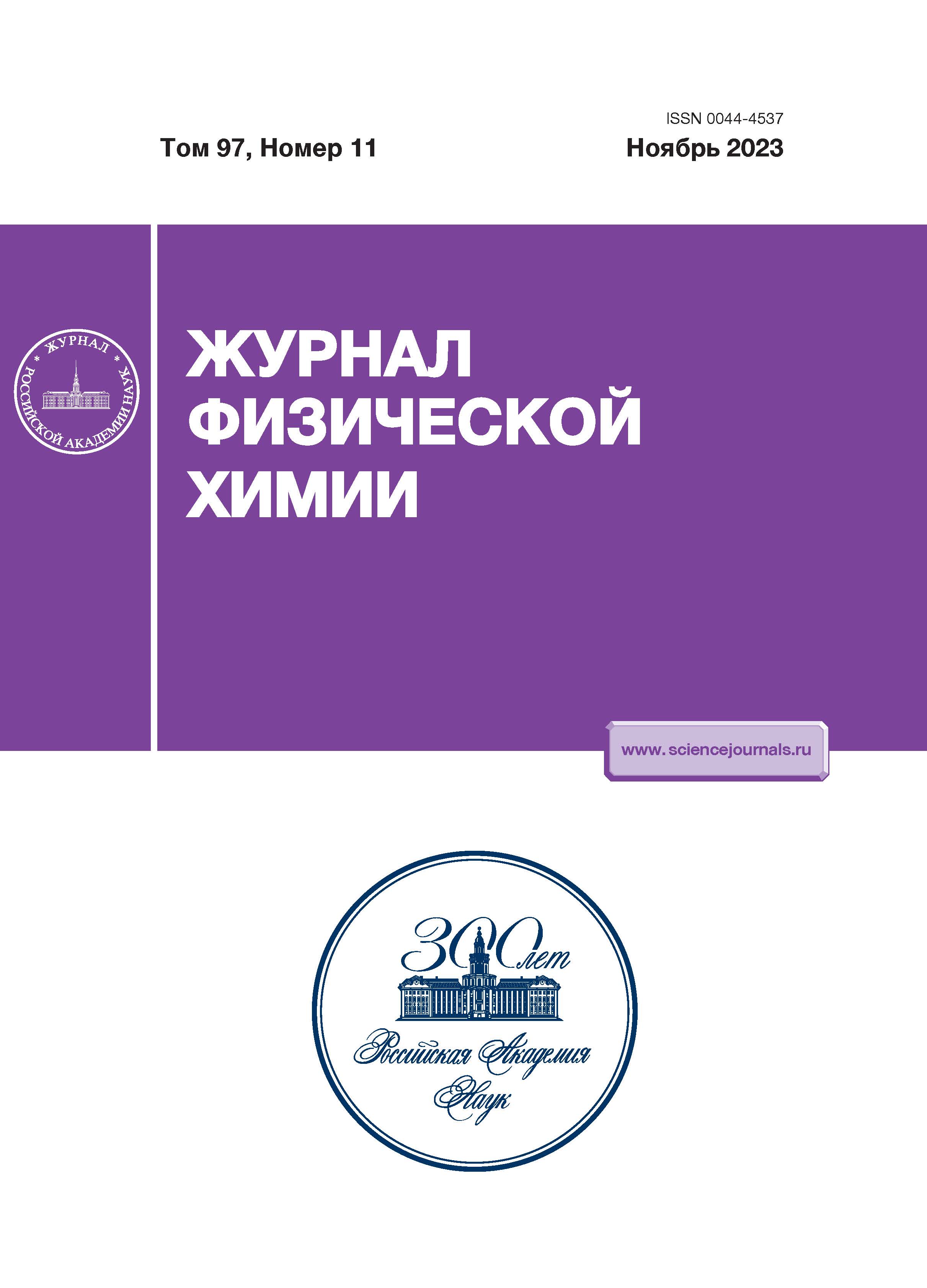Thermodynamics of the Oxygen Reduction Reaction on Surfaces of Nitrogen-Doped Graphene
- Authors: Kislenko V.A.1,2, Pavlov S.V.2, Kislenko S.A.2
-
Affiliations:
- Skolkovo Institute of Science and Technology
- Joint Institute for High Temperatures, Russian Academy of Sciences
- Issue: Vol 97, No 11 (2023)
- Pages: 1547-1555
- Section: CHEMICAL THERMODYNAMICS AND THERMOCHEMISTRY
- Submitted: 27.02.2025
- Published: 01.11.2023
- URL: https://rjeid.com/0044-4537/article/view/669156
- DOI: https://doi.org/10.31857/S0044453723110158
- EDN: https://elibrary.ru/VLDXBV
- ID: 669156
Cite item
Abstract
DFT modeling is used to calculate the free energy profiles of oxygen reduction in acidic and alkaline media on surfaces of nitrogen-doped graphene rather than defect-free graphene. Both four- and two-electron mechanisms of associative reaction are considered. Calculations are made in the grand canonical ensemble at a fixed electrode potential. It is shown that calculations at a fixed potential differ considerably from ones generally accepted at a fixed surface charge. It is found that the electrocatalytic effect of the nitrogen impurity is associated with an increase in the OOH intermediate’s energy of chemisorption that reduces the energy of the oxygen molecule’s protonation reaction. It is also shown that a nitrogen impurity inhibits the two-electron reaction mechanism in an alkaline medium.
About the authors
V. A. Kislenko
Skolkovo Institute of Science and Technology; Joint Institute for High Temperatures, Russian Academy of Sciences
Email: kislenko@ihed.ras.ru
121205, Moscow, Russia; 125412, Moscow, Russia
S. V. Pavlov
Joint Institute for High Temperatures, Russian Academy of Sciences
Email: kislenko@ihed.ras.ru
125412, Moscow, Russia
S. A. Kislenko
Joint Institute for High Temperatures, Russian Academy of Sciences
Author for correspondence.
Email: kislenko@ihed.ras.ru
125412, Moscow, Russia
References
- Ferriday T.B., Middleton P.H. // Int. J. Hydrogen Energy. 2021. V. 46. № 35. P. 18489.
- Ma R., Lin G., Zhou Y. et al. // npj Comput. Mater. 2019. V. 5. № 1. P. 78.
- Zhang L., Lin C., Zhang D. et al. // Adv. Mater. 2019. V. 31. № 13. P. 1805252.
- Wang B., Liu B., Dai L. // Adv. Sustain. Syst. 2021. V. 5. № 1. P. 2000134.
- Jia Y., Zhang L., Zhuang L. et al. // Nat. Catal. 2019. V. 2. № 8. P. 688.
- Begum H., Ahmed M.S., Kim Y.-B. // Sci. Rep. 2020. V. 10. № 1. P. 12431.
- Tabassum H., Zou R., Mahmood A. et al. // J. Mater. Chem. A. 2016. V. 4. № 42. P. 16469.
- Lai L., Potts J., Zhan D. et al. // Energy Environ. Sci. 2012. V. 5. № 7. P. 7936.
- Wan K., Yu Z.-P., Li X.-H. et al. // ACS Catal. 2015. V. 5. № 7. P. 4325.
- Rauf M., Zhao Y.-D., Wang Y.-C. et al. // Electrochem. commun. 2016. V. 73. P. 71.
- Yang H., Miao J., Hung S.-F. et al. // Sci. Adv. 2016. V. 2. № 4. P. e1501122.
- Kim I.T., Song M., Kim Y. et al. // Int. J. Hydrogen Energy. 2016. V. 41. № 47. P. 22026.
- Guo D., Shibuya R., Akiba C. et al. // Science. 2016. V. 351. № 6271. P. 361.
- Okamoto Y. // Appl. Surf. Sci. 2009. V. 256. № 1. P. 335.
- Ikeda T., Boero M., Huang S.-F. et al. // J. Phys. Chem. C. 2008. V. 112. № 38. P. 14706.
- Zhang L., Xia Z. // Ibid. 2011. V. 115. № 22. P. 11170.
- Wan X., Shui J. // Sci. Adv. 2022. V. 1. № 1. P. e1400129.
- Nørskov J.K., Rossmeisl J., Logadottir A. et al. // J. Phys. Chem. B. 2004. V. 108. № 46. P. 17886.
- Yu L., Pan X., Cao X. et al. // J. Catal. 2011. V. 282. № 1. P. 183.
- Oberhofer H. Handbook of Materials Modeling. Methods: Theory and Modeling. Cham: Springer International Publishing, 2018. 1987 p.
- Sundararaman R., Goddard W.A., Arias T.A. // J. Chem. Phys. 2017. V. 146. № 11. P. 114104.
- Kim D., Shi J., Liu Y. // J. Am. Chem. Soc. 2018. V. 140. № 29. P. 9127.
- Kislenko V.A., Pavlov S.V., Kislenko S.A. // Electrochim. Acta. 2020. V. 341. P. 136011.
- Pavlov S.V., Kislenko V.A., Kislenko S.A. // J. Phys. Chem. C. 2020. V. 124. № 33. P. 18147–18155.
- Gao G., Wang L.-W. // J. Catal. 2020. V. 391. P. 530.
- Sundararaman R., Letchworth-Weaver K., Schwarz K. et al. // SoftwareX. 2017. V. 6. P. 278.
- Grimme S., Antony J., Ehrlich S. et al. // J. Chem. Phys. 2010. V. 132. № 15. P. 154104.
- Garrity K.F., Bennett J.W., Rabe K.M. et al. // Comput. Mater. Sci. 2014. V. 81. P. 446.
- Kakaei K., Esrafili M.D., Ehsani A. Chapter 6 – Oxygen Reduction Reaction // Graphene Surfaces / ed. Kakaei K., Esrafili M.D., Ehsani A. Elsevier, 2019. V. 27. P. 203–252.
- Yan H.J., Xu B., Shi S.Q., Ouyang C.Y. // J. Appl. Phys. 2012. V. 112. № 10. P. 104316.
- Gunceler D., Letchworth-Weaver K., Sundararaman R. et al. // Model. Simul. Mater. Sci. Eng. 2013. V. 21. № 7. P. 74005.
- Ashcroft N., Mermin D. Solid State Physics. Cengage Learning, 1976. 848 p.
- Sorescu D.C., Jordan K.D., Avouris P. // J. Phys. Chem. B. 2001. V. 105, № 45. P. 11227.
- Heller I., Kong J., Williams K.A. et al. // J. Am. Chem. Soc. 2006. V. 128. № 22. P. 7353.
- Savin G.I., Shabanov B.M., Telegin P.N., Baranov A.V. // Lobachevskii J. Math. 2019. V. 40. № 11. P. 1853.
- Zacharov I., Arslanov R., Gunin M. et al. // Open Eng. 2019. V. 9. № 1. P. 512.
Supplementary files
















